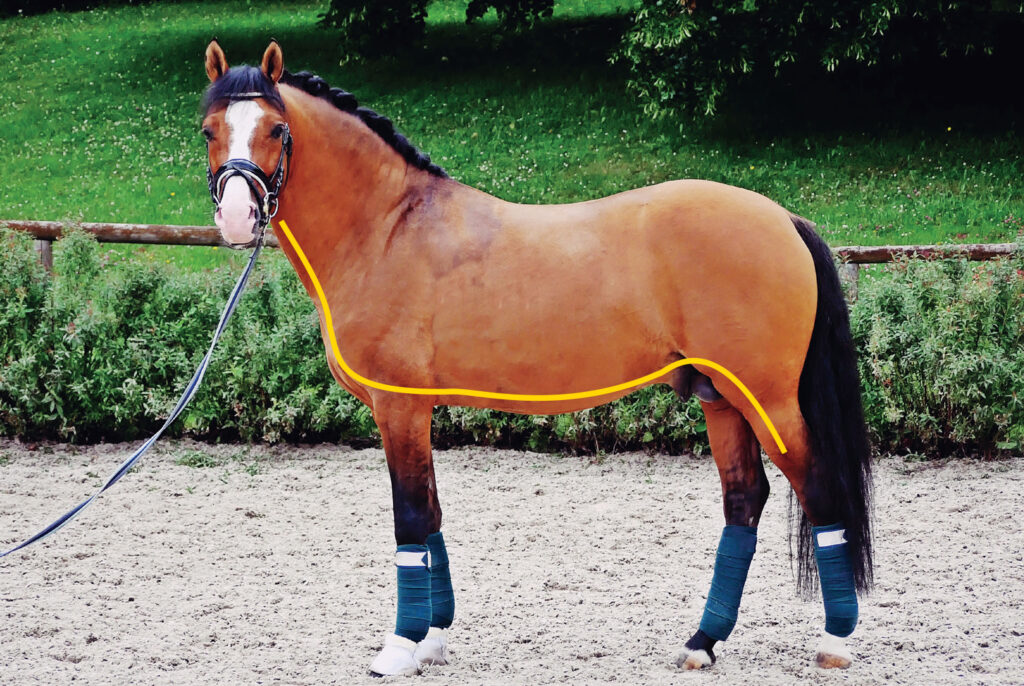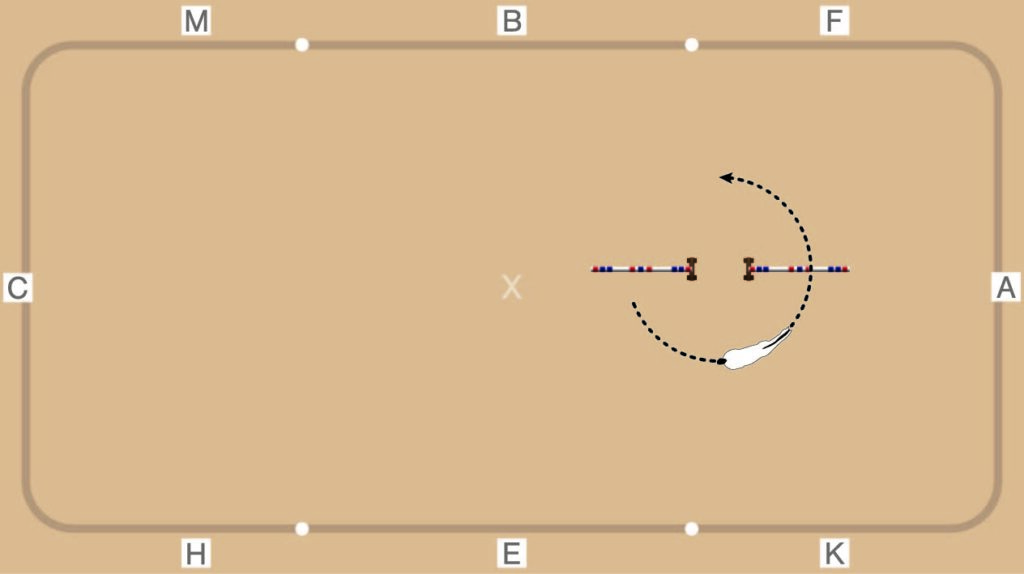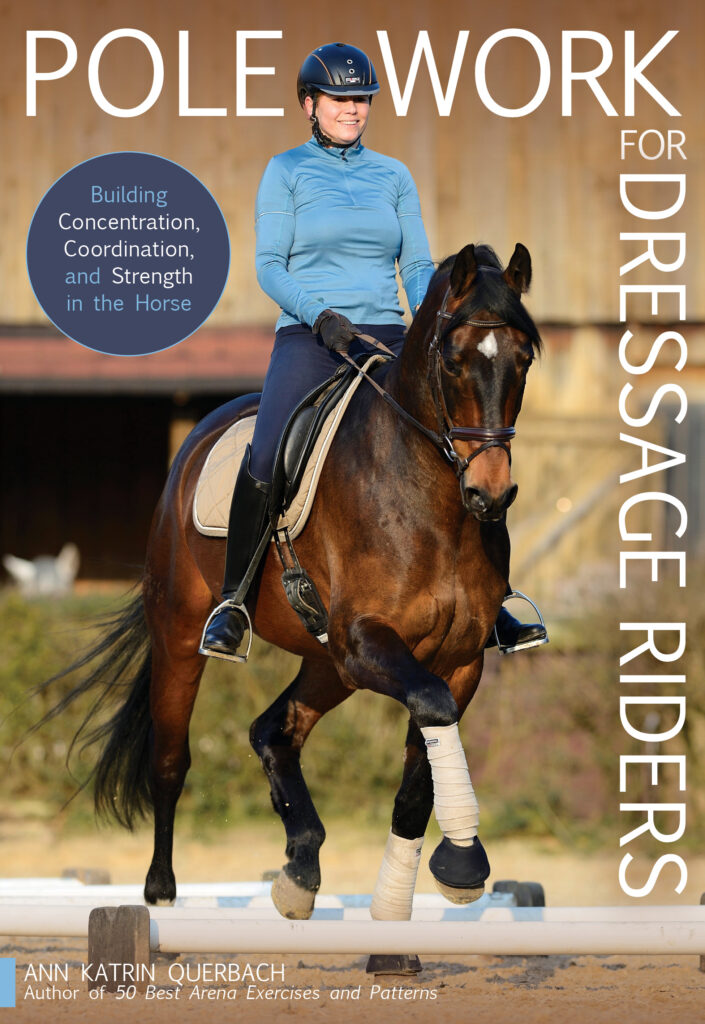There are many advantages that gymnastic exercises with ground poles can offer. For many horses, it’s difficult to maintain an even tempo over a longer period of time. Working over poles is a way to both improve and check up on the horse’s rhythm. This work develops coordination, balance, and concentration for both horse and rider. At the same time, the rider develops a feel for the correct trot, active hindquarters, and lifted back. The rider learns to maintain a “positive tension” (also referred to as “tone” or “engagement”) in her body, even as she stays loose enough to follow the horse’s movement.
The hindquarters are active, as the horse must lift his hind legs significantly higher than usual in order to clear the poles, and the coordination of the dorsal and ventral muscle chains is thereby developed. This causes the horse to lift his back and engage the nuchal ligament of his neck.
A Short Explanation about Muscle Chains
Skeletal muscles function via muscle chains. These chains connect different regions of the body with one another and allow the horse to move. The dorsal and ventral muscle chains are the most well-known—they work antagonistically (against one another).
The Dorsal Muscle Chain
When describing the horse’s dorsal muscles, we are referring to those that run along his back. These begin with the muscles of the upper neck, followed by the ligament system of neck and back, and then the muscles of the back, loin, and croup. Other important muscles are the hamstrings, which are part of the dorsal chain.

Courtesy, Trafalgar Square Books
The Ventral Muscle Chain
This runs along the ventral (belly) side of the horse. This includes the lower muscles of the neck, the abdominals, the flexors of the transition between the thoracic spine and the lumbar spine, the flexors of the lumbo-sacral joint, and the front thigh muscle.
The ventral muscle chain of the neck works closely with the abdominal (belly) muscle chain; in this way, they both strengthen each other. The abdominal muscle chain is composed of multiple muscular layers, which cross over one another on multiple levels. These run from the breastbone over the ribs, all the way back to the pelvic and groin area.

Courtesy, Trafalgar Square Books
Unless these muscle chains are all worked correctly, the horse doesn’t stand a chance of developing the carrying ability and “pushing power” he needs—this results in the false development of his muscles to compensate for their incorrect usage.
What does that mean, exactly? Instead of the correct muscle chains developing, individual muscles take over the work for those that are too weak, just to get through the daily movement required. This might originate with incorrect riding, or because of blockages and tension in the body. If these blockages and incorrect muscular development remain factors for too long, it will have a negative effect on tendons and ligaments, which can lead to inflammation and tears (the dreaded soft tissue injury).
Therefore, I urge you to pay careful attention to the correct muscular development of your horse. If you’re not sure that your horse is developing correctly, you can seek the advice of a veterinarian, physiotherapist, or qualified body worker.
And with the use of pole work, you can check in to make sure your horse is using the correct muscles and demonstrating correct movement patterns. To move correctly, the horse needs good coordination between his hindquarters and forehand.
First, Let’s Look at the Two Sources of Movement
The forehand consists of three active muscle chains: the trunk (responsible for lifting the breastbone); the upper neck; and the straight abdominal muscle. These three muscle chains work together to carry forward the movement and energy generated by the hindquarters. The forehand must be actively engaged in order to avoid damage to the legs or back.
The hindquarters consist of the croup muscles, the straight and transverse abdominal muscles, and the interior lumbar (loin) muscles. It’s only possible for the horse to track up actively and carry weight correctly when his pelvis is able to rotate back and down.
The diaphragm binds these two central sources of movement together. Therefore, the horse must engage his body in a state of “positive tension” in order for him to be able to live a healthy and pain-free life.
Try These Two Easy Pole Exercises at the Walk
Working over ground poles at the walk can help your horse loosen any tension, develop rhythmic and ground-covering strides, and train for various tempos (medium, extended, or collected walk). As the rider, you should aim for a centered seat and suppleness throughout your body—try to disturb your horse as little as possible as he completes the exercises.

Courtesy, Trafalgar Square Books
Lifting the Leg with Correct Flexion
In order to make sure your horse is using the correct muscles—that is, he’s not crooked—place two poles, each with the end toward the middle lifted, on a volte. Now ride over these in the walk.
- Don’t steer as you travel over the poles; just guide and frame your horse over them.
- Continue to ride on the volte over the raised poles until your horse bends correctly and walks over the poles without hitting them.
- As you do so, make sure you frame your horse well but don’t block him. He should be learning to complete the exercise while maintaining positive tension in his body.
- Keep your horse from falling to the outside by using your outside rein to limit your horse. Think about it this way: don’t steer over the poles, just in between them—when all four of your horse’s legs have stepped over the pole.

The Basic Pole Setup at the Walk
To begin pole exercises with “baby steps,” set up three poles along the third track, one after the other, about 2 ½ feet apart. This will prevent your horse from “leaning on” the wall of the arena, while at the same time you can use your aids evenly and correctly. If you’re uncertain about your distances, recruit a helper to watch as you ride past the poles. Your helper can let you know whether your horse’s footfalls are landing alongside the poles or in between them.
Ride at the walk on the third track, using the whole arena. Keep an even tempo. It’s important to allow your horse to walk without rushing him. The correct tempo will depend on his conformation and level of training. For a more highly trained horse, you can shorten his frame easily—meaning the horse can better flex the joints of his hindquarters and thereby become more compact. When doing pole work, we don’t want to ride the horse slowly; we want to improve his carrying power by building up his muscles. This will in turn lead to a higher and more ground-covering stride. At that point, you can work with a shorter distance between the poles.
As you cross the poles, look ahead and allow your hips to swing with the horse’s movement. Guide your horse with a light contact or loose rein.

If the distance between the poles isn’t right for your horse, you can ask your helper to increase it or decrease it as needed. As your training continues, it’s possible the horse’s stride length will change, and you’ll need to adjust the distance between the poles accordingly.
Once you and your horse have mastered this starting point, you can add poles, change formations, and move on to work at different gaits.

This excerpt from Pole Work for Dressage Horses by Ann Katrin Querbach is reprinted with permission from Trafalgar Square Books (www.HorseandRiderBooks.com).











